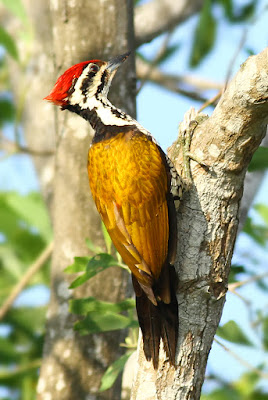The Common Flameback or Common Goldenback
(Dinopium Javanense) is a species of bird in the family Picidae. It is found in
Bangladesh, Brunei, Cambodia, China, India, Indonesia, Laos, Malaysia, Myanmar,
Singapore, Thailand, and Vietnam. The spot-throated flameback is sometimes
considered a subspecies.
Habitat
The Common Flameback frequents moist open forest and
deciduous woodlands, mangroves and scrub. At higher elevation, it frequents
pine forests.It is often seen in cultivated areas, parks and gardens,
and usually in lowlands, but according to the range, also up to 1000, 1500 and
1700 metres of elevation.
Description
The Common Flameback is a large woodpecker.
Its contrasted bright plumage makes this bird a ray of sunlight among branches
and foliage.
Adult male has bright coloured plumage. On the
upperparts, hind neck and upper mantel are black. The rest of upperparts are
olive, strongly washed golden. The feathers are edged yellow and we can see
sometimes orange or red tinge on the back. The lower back and the rump are
bright red. The blackish-brown uppertail-coverts may be tinged olive and the
tail is black. The flight feathers are blackish-brown with white spots on inner
webs. Secondary and tertial flight feathers show olive-yellow outer webs.
On the underparts, the background is white, with edged
and tipped-black feathers giving conspicuous scaled effect, with heavier
markings on the breast. The lower underparts are rather barred than scaled. The
underwing is brown with white spots. The undertail feathers are blackish-brown.
On the head, crown and crest are red, whereas forehead
and upper lores are brownish-red. The crown is finely edged black. The head
sides are black and white, with a black stripe from the eye to the nape, and a
narrow black moustachial line extending down to the upper breast. A white
supercilium extends from above the eye to the nape side, and a broad white
stripe crosses the cheeks from the lores and extends down to neck and breast
sides. Chin and throat are creamy-white, crossed by a line of small black spots
from the bill base to the lower throat.
The bill is blackish with paler base, relatively short
and curved on culmen. The eyes are reddish-brown or brown, with narrow black
eye-ring. The legs and the three toes are grey or brown, often tinged greenish.
The female is very similar but she is duller than
male. On the head, crown and crest are black, finely streaked white.
The juvenile resembles adults. It has blackish-brown
breast with white spots and the lower underparts are darker. The eyes are
greyer.
The young male has black forehead and crown and red
crest, whereas the young female has pale streaks on the crown.
Voice
The Common Flameback utters variable series of notes. In
flight, it gives several “kwop-owp-owp-owp”. When perched, it utters a single
“kow” of two “kow-kow”. We can also hear rattle, harsh “churrrr” and fast
“ka-di-di-di-di”. It also performs rapid drums.
Common Flameback - Bird
Sound (Copyrights YouTube)
General Biology
The Common Flameback is often heard and seen in gardens,
kampong, wooded areas, mangroves and plantations of rubber and coconut. A loud
and sharp call is often uttered as it flies off its vertical perch on a tree.
These birds excavate nesting holes about 3 to 10 m above the ground, usually in
a dead coconut palm.
They can be aggressive, as seen when confronting a
Plantain Squirrel (Callosciurus notatus) or defending its territory from other
males as seen in this peculiar behaviour.
It has been documented that it used tree sap to rid its
feathers of ectoparasites in the phenomenon of "anting" instead of
the usual ants.
As with many birds, it tends to confront its reflection
when in front of a mirror or a glass window.
The Common Flameback attacking its' own image (Copyrights
YouTube)
Behaviour
The Common Flameback feeds mainly on invertebrates,
various insects and larvae. It forages at all levels in woodlands and although
it prefers the lower parts of the trees, it also forages near the treetop or at
mid level.
It gleans and probes in bark crevices and pecks after
removing pieces of bark. It often makes short pauses while climbing quickly. It
also hawks insects.
These woodpeckers are often seen in pairs and sometimes
with other Picidae species. They also consume plant matter such as berries,
fruits and seeds.
During the courtship displays, both mates chase each
other throughout the trees. The displays involve crest-raising, bowing and
head-swinging. The male performs courtship feeding to the female. They nest in
holes in trees. This species is resident in its range.
Justification (IUCN Red List)
This species has an extremely large range, and hence does
not approach the thresholds for Vulnerable under the range size criterion
(Extent of Occurrence <20,000 km2 combined with a declining or fluctuating
range size, habitat extent/quality, or population size and a small number of
locations or severe fragmentation). Despite the fact that the population trend
appears to be decreasing, the decline is not believed to be sufficiently rapid
to approach the thresholds for Vulnerable under the population trend criterion
(>30% decline over ten years or three generations). The population size has
not been quantified, but it is not believed to approach the thresholds for
Vulnerable under the population size criterion (<10,000 mature individuals
with a continuing decline estimated to be >10% in ten years or three
generations, or with a specified population structure). For these reasons the
species is evaluated as Least Concern.







No comments:
Post a Comment